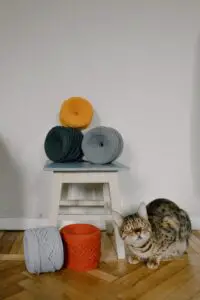
When a cat tends to harm itself, it is absolutely necessary to stop it. But what are the reasons why a cat is self-harming? What you need to know.
Not only cats but also dogs and other pets, accustomed to living in captivity, can develop behaviors for various reasons that in the long run can be very harmful to their health. In particular, felines often have attitudes that manage to damage their own body, so much so as to expose it to infections and even very serious irritations. Let’s see what are the underlying causes of these behaviors and adopt the appropriate remedies to avoid them. What to do when your cat is self-harming.
Behavioral disorders in a cat: what they are
If we think that this expression refers to an unruly cat, we are on the wrong path. Behavioral disorder is an alteration in the feline’s way of doing, which is the direct consequence of both physical and emotional discomfort. In practice, if a cat adopts a harmful behavior towards it, it is not a cat that is well. Discomfort in your cat can be triggered by a variety of factors and results in some unusual actions, especially in a cat that has never had any before.
Let’s take an example: the cat begins to bite off its hair, or obsessively licks the same area of the body until it scales. It will not be enough to scold him to make him stop, indeed it could be even harmful. Equally dangerous is not giving due importance to these behaviors and minimizing them: if they became more and more ‘habitual’, it would be very difficult to correct them later on. But how do we define a feline attitude ‘disturbance’? Here are the behaviors that could trigger the alarm.
The cat is self-harming: the most common behavioral disorders
If the cat is unwell and is experiencing a particular stressful time, it is likely that they are trying to let off steam. It is likely that he will also do it to attract the attention of a master who is too distracted or who does not give him as much attention as he would like. And then it is a ‘gradual disturbance’ that acquires ever greater intensity and frequency. The cat may become addicted to it and may not be able to do without it anymore. But what does the cat do that should make us worry?
- He licks too much: grooming is a widespread practice and certainly not worrying, as it is part of the personal hygiene to which the cat dedicates even half of his day. But if he does it for most of the day, he may feel a skin discomfort that prompts him to rub the part with his tongue to find relief.
- The hair is pulled: very linked to the problem of compulsive licking, it is the behavior of the cat that bites its hair. The ‘favorite’ areas are naturally those that can be reached more easily with the mouth, i.e. inner thighs and belly. Sometimes they can also bite a paw until it bleeds and it is not excluded that this aggressive attitude is also aimed at strangers and people who live with it.
- Ingests objects: this phenomenon, known as ‘picacism’, is very dangerous because it consists in the habit of ingesting any object under the paws. This could not only induce him to introduce into his body toxic and poisonous substances but also objects that could cause damage and difficulty in the functioning of the respiratory system.
- He runs away and suddenly runs: if the cat walks away terrified, as if he had seen some kind of frightening element, he could suffer from hallucinations. If this sudden rush is accompanied by intense vocalizations and meowing, the cat is likely to see what doesn’t actually exist. Conversely, they may also hallucinate from standing still and staring into space or a wall.
- Try to catch the tail: if the cat starts running circles on itself, in a vain attempt to reach the tail, almost as if it were an element foreign to its own body, it has a behavioral disorder.
- Sucks the fabrics: in particular when the cat sucks the wool or sticks to a cloth towel, it does so because it is an attitude that calms them. With this attitude they tend to repeat the moment of breastfeeding, when they were in fact safely attached to the mother cat’s breast. It’s a bit like our ‘sucking our finger’, even when we grow up: a way to escape from reality and rethink old times.
The cat is self-harming: the possible causes
A cat that carries out one of the aforementioned behaviors is in the throes of a craving, excessive agitation and excitement. It is no coincidence that these obsessive compulsive disorders are, generically, enclosed under the same definition of ‘feline hyperesthesia’: it is a fairly rare neuromuscular system disorder, which exposes the cat to an evident hypersensitivity in some parts of the body. But what are the underlying causes of these strange behaviors? Let’s see them all.
- He wants to attract attention: especially that of his master, who is perhaps too busy to care for him.
- DNA: sometimes it is a genetic predisposition of some breeds to induce the cat to certain behaviors. Think for example of the Siamese or Burmese: it is easy to see them sucking on fabrics such as wool.
- Stressful or traumatic events: when the cat is uncomfortable, feels stressed or is forced to live in frustrating situations, it can also suffer from skin irritations. These red, chapped areas can cause him to compulsively lick himself for relief.
- Dermatological problems: sometimes these are the trigger for obsessive behavior such as compulsive licking. It is the same discomfort caused by this skin problem that causes the cat to find relief in this way. We contact the vet immediately for a visit, as it may already be too late.
How to remedy a cat’s self-harm

If we notice self-destructive behavior in our beloved feline, it is absolutely necessary to intervene, but how? Certainly losing patience, or worse, would be useless, if not to undermine the relationship of trust that has been established between human and animal. If we think that the cat is doing it just to get our attention, let’s surprise him with an absolutely unexpected attitude: ignoring him!
We avoid encouraging these behaviors, perhaps with pampering and attention, as this could lead them to repeat them. Your best bet is to try to distract him and get his attention with something else, be it a toy or his favorite snack. Having a home full of ‘entertainment and distractions’ can also be very useful in cases like this: often it is also boredom that leads the cat to assume certain self-injurious behaviors.
If we understand the cause of your ailment, we try to avoid it when and if possible. If this were not the case, let us contact an expert, who could also prescribe drug therapy. An ethologist, expert in animal behavior, is usually the right key for particularly severe cases and ‘resistant’ to treatment.






